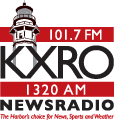KXRO
KXRO (1320 kHz) is a commercial AM radio station broadcasting a news/talk radio format.[1] Licensed to Aberdeen, Washington, the station serves the Grays Harbor section of Washington. It is currently owned by Alpha Media LLC.[2]
 | |
| City | Aberdeen, Washington |
|---|---|
| Broadcast area | Grays Harbor |
| Branding | KXRO Newsradio |
| Slogan | "The Harbor's Choice for News, Sports and Weather" |
| Frequency | 1320 kHz |
| Translator(s) | 101.7 K269FT (Hoquiam) |
| First air date | May 28, 1928 |
| Format | News/Talk |
| Power | 5,000 watts day 1,000 watts night |
| Class | B |
| Facility ID | 52674 |
| Transmitter coordinates | 46°57′27″N 123°48′34″W |
| Former frequencies | 1320 kHz (1927-1928) 1340 kHz (1928) 1420 kHz (1928-1929) 1310 kHz (1929-1941) 1340 kHz (1941-1950) |
| Affiliations | Premiere Networks Westwood One CBS Radio News |
| Owner | Alpha Media LLC (Alpha Media Licensee LLC) |
| Website | kxro.com |
KXRO is also heard on a 250 watt FM translator, 101.7 MHz K269FT in Hoquiam.[3]
Programming
Weekday mornings begin with a news and information program, the "KXRO Morning News." That's followed with a call-in show, "Live @ Nine." The rest of the schedule is made up of nationally syndicated shows including Dave Ramsey, Clark Howard, Thom Hartmann, Dana Loesch, Clyde Lewis and Coast to Coast AM with George Noory. Most hours begin with world and national news from CBS Radio News.
History
KXRO dates back more than 90 years, first signing on the air on May 28, 1928. Its studios and offices were originally located in Hotel Morck, a noted resort hotel in Aberdeen.[4] Its power was only 100 watts at first, and it was owned by KXRO, Inc. It spent time on several different radio frequencies.
With the enactment of the North American Regional Broadcasting Agreement (NARBA) in 1941, KXRO moved to 1340 kHz, powered at 250 watts.[5] It was a network affiliate of the Mutual Broadcasting System and the Don Lee Network during the "Golden Age of Radio."
In 1950, KXRO moved to 1320 kHz, its current dial position. That was coupled with an increase in power to 1,000 watts. In the 1960s, it got another boost in daytime power, to 5,000 watts.[6] As the era of network programming ended for radio and moved to television, KXRO adopted a full service middle of the road music format.
By the 1990s, KXRO had moved from a mix of music and talk to all talk.
References
- "Station Information Profile". Arbitron. Summer 2009. Retrieved 2010-02-13.
- "KXRO Facility Record". United States Federal Communications Commission, audio division. Retrieved 2010-02-13.
- Radio-Locator.com/K269FT
- Broadcasting Yearbook 1935 page 60
- Broadcasting Yearbook 1943 page 150
- Broadcasting Yearbook 1970 page B-215
External links
- Query the FCC's AM station database for KXRO
- Radio-Locator Information on KXRO
- Query Nielsen Audio's AM station database for KXRO
- Query the FCC's FM station database for K269FT
- Radio-Locator information on K269FT
- FCC History Cards for KXRO